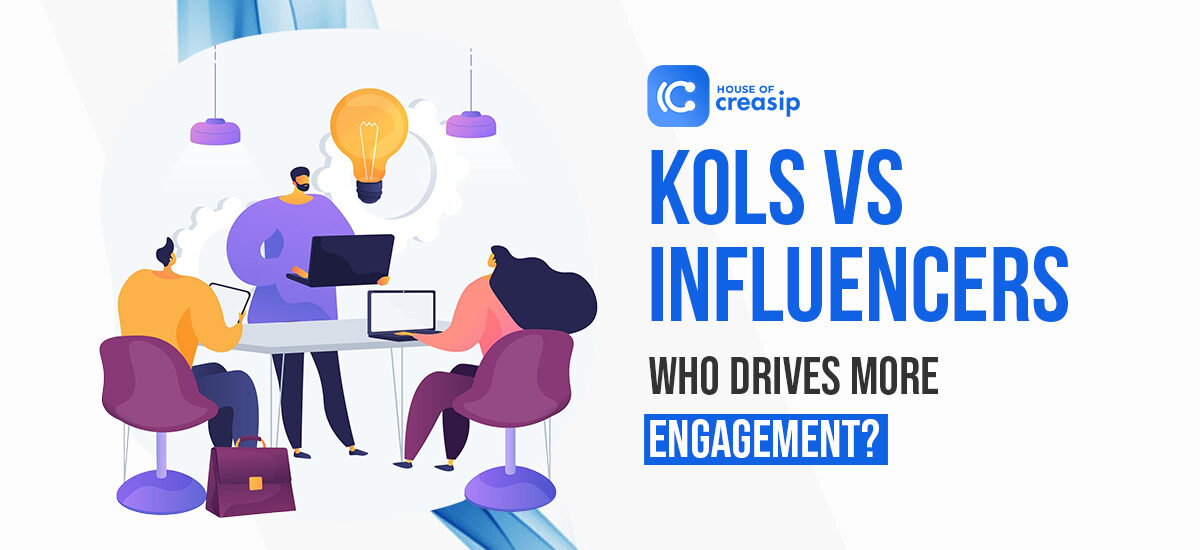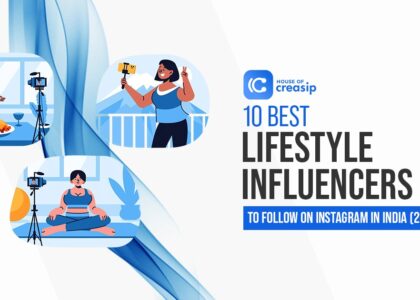KOLs vs Influencers: Who Drives More Engagement?
Do you know that brands heavily rely on unique individuals to engage and resonate with their target consumers in a significant manner? These individuals are commonly known as influencers and Key Opinion Leaders (KOLs). Today, they have become central to marketing strategies and campaigns worldwide. Individuals are now relying on approachable personalities and authoritative experts for product endorsements, lifestyle inspiration and well-informed advice, as trust among customers in traditional advertising is fading.
KOLs vs Influencers is a common comparison in the marketing world, as both have a crucial impact on consumer behaviour.However, they are not the same; they have some differences. For instance, Influencers tend to develop followers by creating innovative content and having a strong social media presence. Whereas KOLs gain their credibility through years of experience, expertise and achievements within their industries. These essential differences influence not only how they interact with groups but also how their endorsements are perceived.
What are Influencers?
Influencers are individuals who have amassed a substantial following on social media platforms such as Instagram, YouTube, TikTok, and Twitter by creating and sharing creative, unique, and relatable content, while also engaging in continuous interaction. Their influence comes from the fact that they can connect with people at a personal level. Influencers can be a beauty blogger, fashion stylist, fitness enthusiast, gamer, food critic or lifestyle creator.
They frequently work with brands to support products or services through paid collaborations, sponsored posts, contests and product reviews. The authenticity of influencers and the trust they have earned from their followers is what makes them precious to brands. Their work is typically seen as more authentic compared to traditional advertisements, which enhances consumer engagement and increases return on investment (ROI).
What are KOLs?
KOLs, also known as Key Opinion Leaders they are the people who are viewed as experts or authorities in a particular field. They can be doctors, professors, tech analysts, industry leaders, and even journalists with high credibility and professional reputation. In contrast to social media influencers who become popular on a specific platform. (KOLs) Key Opinion Leaders typically have respect based on years of experience, education and experience in a specialised field.
For instance, a doctor prescribing a brand of skincare on social media would qualify as a KOL in the wellness and healthcare sector. A finance professor making economic forecast commentary would be a KOL in the banking and finance sector. KOLs command decision-making based on trust, expertise and professional reputation, without any flashy looks or entertainment.
Whether your strategy requires the widespread reach of an influencer or the targeted precision of a KOL, selecting the right voice is crucial to success.
At House of Creasip, India’s top influencer marketing agency, we specialise in connecting brands with voices that truly drive results. We help you build campaigns that resonate, engage, and convert, from niche industry experts to viral digital creators. Let’s build something impactful together. Get in touch with us today and watch your brand influence grow.
KOLs vs Influencers: What Sets Them Apart?
Despite Influencers and KOLs sharing the ability to impact consumer decisions. Influencers and KOLs differ notably in credibility, audience interaction, preferred platforms, and influence strategies.
1. Credibility and Expertise
Influencers derive legitimacy through appeal and relatability. They can be or may not necessarily be experts in the niche, but are appreciated for creative content and audience connection. KOLs, however, are well-established professionals who are recognised as having extensive expertise and authority on a specific topic.
Example: A fitness influencer may post workout advice and product reviews based on individual experience. On the other hand, a sports physiologist (KOL) makes recommendations based on evidence and research.
2. Platform and Reach
Influencers work mainly on social media, which helps them generate a following through regular posting and engaging with the audience. They have visual content that is interactive and algorithm-optimised. KOLs also exist on social media but work mainly through industry publications, academic journals, webinars, conferences, and quality websites.
Example: A fashion influencer shares daily fashion inspiration on Instagram, whereas a fashion designer (KOL) may deliver talks at fashion summits or have an article in Vogue or Business of Fashion.
3. Audience Trust
Although both influencers and KOLs command audience trust, the type of trust is different. Influencers create emotional trust and similarity, through which the audience sometimes feels a personal attachment with them. KOLs are trusted for objective views and factual information. Their words offer guidance in business and high-stakes situations.
Example: To select a new skincare routine, one may consult an influencer’s opinion. But to treat serious skin issues like acne, they’d be trusting a dermatologist’s (KOL) advice.
4. Influence Strategy
Influencers make users do impulse purchases with calls to action such as “swipe up to buy” or “use my code.” KOLs do work for long-term reputation establishment and educational value, so their influence is more subtle but strong in the long term.
Example: A beauty influencer may say, “Love this serum! Use code GLOW10.” Meanwhile, a dermatologist (KOL) might recommend the same serum in a video explaining its ingredients, building trust over time.
Why is There Confusion Between KOLs and Influencers?
The difference between influencers and KOLs is sometimes blurred. As more experts use social media to spread their expertise, most KOLs are using influencer-style content. Others are broadening their knowledge to become half-experts in their areas.
Additionally, the word “influencer” has now been made into an inclusive term that is applied to anyone who has followers, irrespective of their authority. Thus, brands and consumers both tend to find it difficult to distinguish between the two.
Brands Should Know When to Choose KOLs Instead of Influencers
Collaborating with a Key Opinion Leader (KOL) or an influencer is based on your brand’s objectives, audience and the niche of your business. Both are essential to digital age marketing, but for different reasons and with differing types of impact.
KOLs are best suited if you are looking to promote campaigns that need to be validated by experts, explained technically and need huge credibility. These people tend to be established professionals as researchers, doctors, educators and industry experts who have earned their authority after years of experience. They exercise influence not through being relatable but through their expertise. Thus, best suited for industries where precision and trust go without saying. Brands in the sectors of pharmaceuticals, health supplements, financial services, educational platforms, B2B services and public policy advocacy frequently use KOLs.
These brands have listeners looking for fact-based knowledge and opinions supported by experts before making a purchasing decision. A KOL endorsement not only establishes credibility but also gives the audience confidence that the product or service is of high quality and can be trusted.
In contrast, influencers work best for virality, engagement and direct response campaigns. They have solid relationships with their fans via engaging, lifestyle-based content. Influencers are best utilised in sectors like fashion, food, travel, beauty, lifestyle, fitness and consumer tech and where aesthetics, familiarity and trendiness influence buyer behaviour. If you want to establish brand awareness quickly and resonate with a younger, digitally-savvy audience, influencers provide the speed and scale brands require.
Can KOLs and Influencers Work Together?
Indeed. The strongest marketing efforts are frequently a synergy of the KOL’s credibility and the reach and familiarity of an influencer. For instance, a technology brand that is introducing a new smartwatch could partner with both:
A technology reviewer influencer who features product use, style, and lifestyle compatibility.
A sports scientist (KOL) who describes the health improvements and precision of the fitness tracking functionality.
These collaborations offer a complete story, appealing to emotion and reason, trust and trend.
The Rise of KOL Marketing in India
Key Opinion Leader (KOL) marketing is increasing rapidly in India as brands are now shifting from conventional advertisements to authentic, expert voices. KOLs are experts in their respective categories, such as finance, technology, fashion, and their recommendations sound more authentic to audiences.
With the regional diversity of India, native KOLs are assisting brands in reaching out intensely to specialised markets. They develop content that speaks to particular communities, particularly in Tier 2 and Tier 3 cities, thus makes the campaign stronger.
KOLs are also perceived as teachers, rather than merely being spokespeople. For instance, a KOL in finance may simplify investment advice in simple terms, assisting followers in making more informed decisions while gaining the trust of the brand they stand for.
Brands today are collaborating with micro and nano KOLs, which have smaller but loyal audiences. This method provides improved return on investment (ROI) as such KOLs drive actual decisions and long-term loyalty.
Overall, the growth of KOL marketing in India reflects a transition towards genuine, informative, and community-based communication. It is a tactic that forms a main strategy in the digital marketing sphere.
Metrics to Measure KOLs vs Influencers
When comparing KOLs vs Influencers, brands should measure performance using different metrics:
Influencers have engagement rate, reach, follower growth, aesthetic of the content and brand fit.KOLs have citations, industry awards, media quotes, credibility score, and depth of analysis.
There are some platforms today that provide KOL identification tools to assist brands in monitoring expert reputation on LinkedIn, research journals and so on.
Challenges with KOL and Influencer Marketing
Both influencer and KOL marketing have challenges. Influencers can be challenged on credibility if they endorse too many brands or are not transparent. KOLs may not always possess the storytelling ability or platform reach desired by brands.
That’s where strategy comes in. Brands must pair the right voice with the right objective, and not take a one-size-fits-all shot.
Conclusion
In conclusion, both KOLs and influencers are influential shapers of opinion and consumer behaviour. While influencers work on personality-centric content, storytelling and engaging with a community, KOLs add value by providing in-depth knowledge, fact-based credibility and thought leadership. Both offer distinct types of value to the table and choosing the correct match must be informed by the brand’s message, target market, industry, and end goal.
In the rapidly evolving marketing landscape of 2025, distinctions between KOLs and influencers can further blur as more experts establish online presence and more influencers develop niche authority. Yet there is a fundamental difference between influence through connection and influence through credibility; this will still be important.
Brands that acknowledge, understand and strategically combine both roles will be much better positioned to build trust, establish loyalty and break through the digital wall. By combining the authentic voice of an influencer with the expert endorsement of a KOL. Brands can create more integrated, high-impact campaigns that resonate highly and achieve true outcomes.



